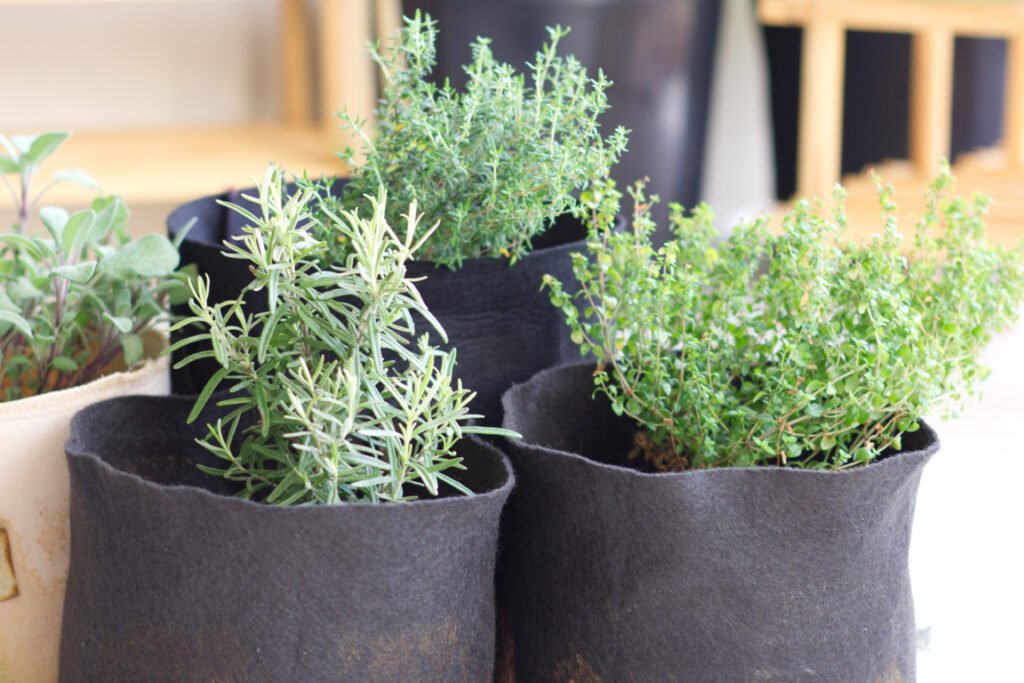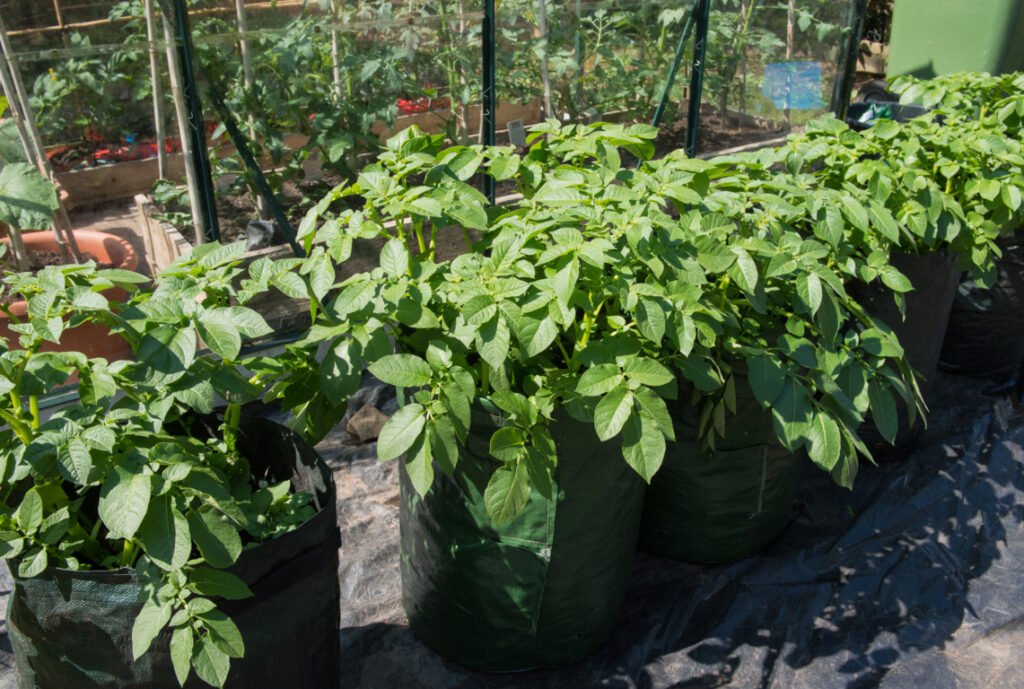
A farmer friend of mine used to wear a hat that said “Smart Pot” with a little picture of a flower on it. I didn’t quite understand what it was promoting.
Was it some kind of incognito cannabis reference? What was a smart pot?
After a few trips to grow stores I realized that this was just one brand of many very popular growing containers. Still, the first time I saw a fabric container I didn’t quite comprehend what they were supposed to be.
How could a pot made of woven fabric be used to grow plants? What a strange concept.
But after giving them a shot, I immediately understood the appeal. I wondered why I hadn’t tried them sooner!
Since then, I’ve been a huge advocate for using this type of container. They’re durable, lightweight and do wonders for the development of plants’ roots. I’ve grown just about every type of plant in them, with lots of success.
From herbs, like basil and dill, to essential garden vegetables (or fruit, for you sticklers) like tomatoes and peppers. Surprisingly, potatoes grow exceedingly well in fabric pots.
Need more convincing to give them a try? Read on to learn all about these innovative pots.
Consider Fabric Pots in Lieu of Traditional Containers
Compared to conventional gardening pots made of plastic, terra cotta, wood, concrete or ceramic, fabric pots stand out in an obvious way. The material they consist of is a finely woven fiber made from BPA-free polypropylene. The end result is a flexible, durable, breathable felt-like material.
The price for a fabric pot will be a little more expensive up front, but they provide better growing conditions for your plants and last a long time with proper care.
Now that we’ve piqued your interest, let’s explore all of the advantages of growing with fabric containers.

The Advantages of Using Fabric Pots
Now, we’ll count the ways that fabric pots are superior to traditional gardening pots.
Unrivaled Drainage
Because they’re made of porous fiber, fabric pots will never retain unhealthy amounts of moisture. Any excess water will pour right out. Overwatering is a common issue for gardeners, even when they don’t realize it. This problem is completely eliminated when using fabric containers.
Aeration of the Roots
Distinct from any other material, fabric allows the free flow of air to reach a plant’s roots. Containers made of solid materials often end up root bound. Without aeration, roots grow until they reach the limits of a container. When this happens it signals to the plant to grow more roots. The plant eventually ends up rootbound, smothering itself with a mass of roots.
Healthy Roots
The problem of rootbound plants is not an issue with fabric containers. Roots that reach the wall of the fabric are burned off. The plant then produces fresh new roots, growing out from the original. This natural occurrence is referred to as air pruning. In traditional pots the roots will circle and become a tangled mess, leading to lack of proper drainage and aeration.
The regenerative process of air pruning leads not to a mass of strangled roots, but a more fibrous root system. The fine root hairs that are produced are much more capable of taking up water and nutrients.
Temperature Regulation
Solid containers get very hot sitting in direct sun. They have no way of releasing the buildup of hot temperature. The poor roots end up baking with no relief from the heat. This is not an issue with fabric pots. Their porous nature allows them to readily release heat from all sides.
Portable, Adaptable and Available
Fabric containers are lightweight and moved around garden spaces with ease. Their malleability allows them to be packed together closely or stuck into tight spaces. If inclement weather or freezing temperatures are threatening, they can effortlessly be pulled into a garage, shed or greenhouse. Oftentimes they are equipped with built in handles, making transport even easier.
Fabric containers are available in every imaginable size and color. You can grow something as small as an indoor plant in a 3 gallon pot, or something as large as a tree in a massive 100 gallon container. You can select the appropriate size container, depending on how large you’d like your plants to get.
Durable
Fabric containers will easily outlast standard plastic containers. When cared for properly they can hold up for 5 years or more. Move them with care, especially when they’re heavy after a watering, to prevent any tearing along the seams.
Storable
Fabric containers are easily emptied, washed and folded up at the end of the season. They can be stored in almost any nook or cranny of a garage, shed or basement. No more unsightly stacks of ragged, plastic pots laying around all over the garden!
Lastly, we can take a look at the best ways to plant and grow with fabric containers.

Best Practices for Fabric Container Gardening
Filling and Planting
Fabric containers can be planted out much the same way as traditional pots. It may be wise though to incorporate a growing medium that retains moisture well. Seeing as there is nothing impeding drainage, a soil that holds water will be beneficial. Consider mixing in peat moss, compost, or coconut coir to increase moisture retention.
When filling the container with soil, make sure to lightly tamp down all around the fabric sides as you go. This will help the soil settle into place and you won’t end up with air pockets or a flimsy container. Once full, squish and shake the pot to distribute all the soil evenly and tamp down again. Then, it’s ready to be planted. Don’t forget to mulch after transplanting!
Watering
When watering a fabric container remember to go slow and easy. A huge blast of water will be wasted by quickly running over the top and out the sides. Watering slowly will make sure all of the soil is evenly damp.
Overwatering won’t be an issue with a fabric pot, but they do require more frequent watering. They tend to dry out more quickly due to excellent aeration and drainage. It’s one of the few drawbacks of fabric pots. Just keep a close eye on them on hot days and use a moisture meter to determine whether or not they need water. Setting up an automatic drip irrigation system will prevent the pots from drying out.
Fertilizing
Fabric containers don’t hold as much soil as a garden bed, so plants will need to be fed more often throughout the course of the season. Work in small amounts of natural fertilizers regularly to get the best results.
Frequently Asked Questions (FAQ)
What are the benefits of fabric containers?
The material used in fabric pots allows air to pass through the soil and roots. If you have plants that suffer from mold or root rot, fabric containers are a great choice. Superb drainage is another feature of fabric pots. Overwatering will not be an issue, compared to traditional growing containers.
What can I plant in a fabric pot?
Almost any plant will thrive in a fabric pot. Excellent aeration and drainage make it easy to have success growing your favorite garden plants.
What’s the best way to store fabric pots in the winter?
Fabric pots should be emptied of all soil and can then be thrown into a washing machine. Add some vinegar and baking soda for thorough cleaning and sterilization. Fabric containers will last longer when kept clean and stored away from the outside elements.
How long will my fabric container last?
Fabric containers usually outlast cheaper plastic pots. They only begin to tear and disintegrate after many seasons. Plan on getting quality use out of fabric containers for 3-5 years if well maintained, more if used for indoor plants.



